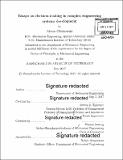| dc.contributor.advisor | Steven D. Eppinger. | en_US |
| dc.contributor.author | Olechowski, Alison L. (Alison Louise) | en_US |
| dc.contributor.other | Massachusetts Institute of Technology. Department of Mechanical Engineering. | en_US |
| dc.date.accessioned | 2017-10-18T15:11:01Z | |
| dc.date.available | 2017-10-18T15:11:01Z | |
| dc.date.copyright | 2017 | en_US |
| dc.date.issued | 2017 | en_US |
| dc.identifier.uri | http://hdl.handle.net/1721.1/111942 | |
| dc.description | Thesis: Ph. D., Massachusetts Institute of Technology, Department of Mechanical Engineering, 2017. | en_US |
| dc.description | Cataloged from PDF version of thesis. | en_US |
| dc.description | Includes bibliographical references (pages 123-130). | en_US |
| dc.description.abstract | This thesis presents three essays on the topic of tools for assessment and decisionmaking in complex engineering systems development. The first essay presents an extension to the design structure matrix, used to present and analyze the suite of tests a system undergoes at multiple levels of the architecture. This method decomposes the multilevel integration test suite - progressing from component to subsystem to system - and visually represents the test coverage. We demonstrate the new method on a subsea system at BP. The second essay presents a study of the current state of use of the technology readiness level method. We discovered, described and prioritized 15 challenges associated with assessing and using the technology readiness levels. We further discuss existing and potential solutions to these challenges. This paper is based on input from interviews at seven different organizations, and a survey of over 100 system engineers. System complexity related challenges were found to be particularly critical and currently without adequate solution. The final essay presents an expansion of our current understanding of the options available at a phase-gate review. Beyond the typical Go and Kill options, we describe the Waiver (with and without review), Delay and switch to a Back-up plan options. We show how it is feasible to extend a simple decision tree model to analyze the expected value of this broader set of options. We demonstrate this method with four case applications from industry. | en_US |
| dc.description.statementofresponsibility | by Alison Olechowski. | en_US |
| dc.format.extent | 130 pages | en_US |
| dc.language.iso | eng | en_US |
| dc.publisher | Massachusetts Institute of Technology | en_US |
| dc.rights | MIT theses are protected by copyright. They may be viewed, downloaded, or printed from this source but further reproduction or distribution in any format is prohibited without written permission. | en_US |
| dc.rights.uri | http://dspace.mit.edu/handle/1721.1/7582 | en_US |
| dc.subject | Mechanical Engineering. | en_US |
| dc.title | Essays on decision-making in complex engineering systems development | en_US |
| dc.type | Thesis | en_US |
| dc.description.degree | Ph. D. | en_US |
| dc.contributor.department | Massachusetts Institute of Technology. Department of Mechanical Engineering | |
| dc.identifier.oclc | 1005924028 | en_US |
